Elm Coulee Oil Field
| Elm Coulee | |
|---|---|
 Location of Elm Coulee | |
| Country | United States |
| Region | Montana |
| Location | Richland County |
| Coordinates | 48°2′33″N 104°27′58″W / 48.04250°N 104.46611°WCoordinates: 48°2′33″N 104°27′58″W / 48.04250°N 104.46611°W[1] |
| Field history | |
| Discovery | 2000 |
| Production | |
| Current production of oil | 53,000 barrels per day (~2.6×106 t/a) |
| Producing formations | Bakken formation |
Elm Coulee Oil Field was discovered in the Williston Basin in Richland County, eastern Montana, in 2000. It produces oil from the Bakken formation and, as of 2007, was the "highest-producing onshore field found in the lower 48 states in the past 56 years."[2] By 2007, the field had become one of the 20 largest oil fields in the United States.[3][4]
Papers like "Petroleum Geology of the Bakken Formation - Williston Basin, North Dakota and Montana" from the Economic Geology of the Williston Basin: The Montana Geological Society 24th Annual Conference, 1978 Williston Basin Symposium, p. 207-227" by Fred Meissner, were very astute and forward thinking, even predicting the Elm Coulee Field area. Working from these papers, geologist Richard Findley saw that the dolomitic middle Bakken member often had oil shows, and mapped a large area that showed promise, which he called "Sleeping Giant". Two wells in the area had made significant production from the Bakken in vertical boreholes, which was very unusual.
The area was too large for a small operator like Findley, so he submitted his concept to Lyco Energy of Dallas, Texas in 1996, and Lyco promptly decided to take the project on, with Findley retaining a small ownership interest. Lyco began leasing in 1996, and then re-entered nine old vertical wells as a test, completing them with 100,000 lb fracs in the middle Bakken formation in 1996-7. The results were mixed, but confirmed that the Middle Bakken was saturated with producible oil, and would respond to a frac.
Although there were a handful of horizontal wells being fracced in the Barnett Shale of Texas at the time (1997-8), those activities were not yet released. So, with no data available for an analogy, Lyco's geologist (Michael Lewis) and engineers (Charles Wiley and Gary Dittmar) set out to design the initial test well. Because of the relatively high cost and large potential scope of the project, Bobby Lyle (president of Lyco) decided that it would be prudent to involve investors. So, the Lyco team sought funding from numerous financial institutions and a few independent oil companies. But, the project was viewed as too risky, since there was no analogy for the concept. Finally, Halliburton agreed with Lyco's assessment of the potential, including the potential boon for its stimulation business, and agreed to support Lyco's operations financially through its commercial services division.
Lyco drilled the first horizontal well in the field, the Burning Tree State #36-10 in late 1999, as the oil price moved upwards toward $20 per barrel. Although designed as a 3,000 foot lateral, the well was terminated early due to hole stability issues. Production casing was run to bottom and cemented, then perforated in three intervals over the roughly 1,000 foot lateral; at the toe, the middle and the heel. The well flowed oil immediately, at 196 barrels per day,[5] and continued flowing for several months. Finally, the well was fracced, with a substantial increase in production. Lyco then began a continuous drilling program, progressing to 3 rigs and beyond. Headington, another oil company in the area that happened to own leases, began a drilling program also, followed by Continental and others who rushed in to take lease positions on this new, hot play.
At Elm Coulee, the Middle Bakken is a dolomite sandwiched between the Upper and Lower Shales. The shales are very rich in organic material, and the oil generated from them expanded from the shales upon reaching thermal maturity, migrating into this Middle Bakken zone. The field is exploited via horizontal drilling technology by perforating the productive rocks parallel to the beds, rather than through a vertical well perpendicular to the relatively thin Bakken formation. At Elm Coulee Field, the Bakken is only about 45 feet (15 m) thick and lies at depths of 8,500 to 10,500 feet (2,600–3,200 m), but horizontal wells penetrate 3,000 to 10,000 feet (900–3,000 m) of the reservoir rock, a porous dolomite of Devonian age that probably originated as a large carbonate bank on the western flank of the basin. The field is a stratigraphic trap.[6]


In 2006, Elm Coulee was producing about 53,000 barrels (8,400 m3) of oil per day from more than 350 wells. Ultimate production is expected to exceed 270 million barrels (43,000,000 m3),[7] with some estimates as high as 500 million barrels (79,000,000 m3).[8] Production at Elm Coulee has more than doubled the oil output of the state of Montana, from around 40,000 barrels per day (6,400 m3/d) in 2000 to almost 100,000 barrels per day (16,000 m3/d) in 2006. However, Montana production fell again starting in 2007, down to some 70,000 barrels per day (11,000 m3/d) in mid-2009.[9][10]
References
- ↑ "Elm Coulee". Geographic Names Information System. United States Geological Survey.
- ↑ Wall Street Journal, quoted in Big Sky Business Journal.
- ↑ Petroleum Technology Transfer Council Newsletter, Vol. 9, 2006.
- ↑ Energy Information Administration list of top 100 oil fields (link malfunction).
- ↑ Sourcing an oil boom, GeoExPro.
- ↑ Elm Coulee Field, Middle Bakken Member, by Bill Walker, Al Powell, Dick Rollins, and Ron Shaffer, 2006.
- ↑ Elm Coulee Field.
- ↑ USGS estimates of Bakken oil production.
- ↑ Jennifer McKee, Montana Standard State Bureau, Dec. 2, 2007.
- ↑ Production figures for Montana by EIA
